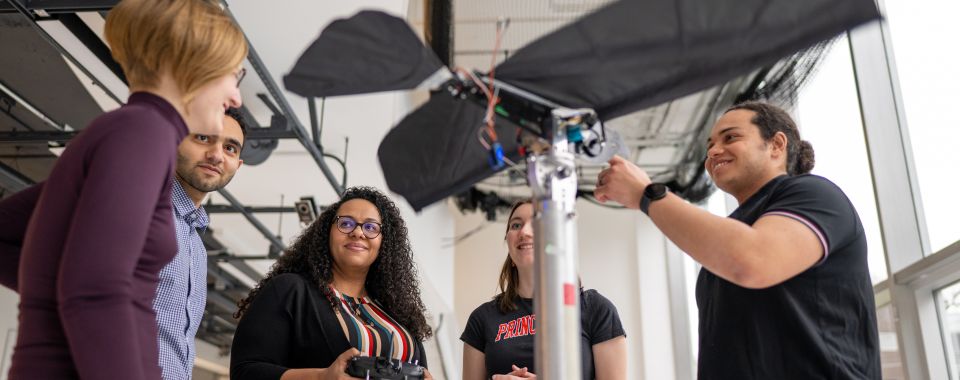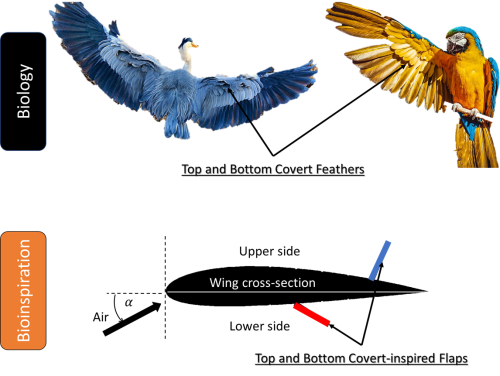
Diaa Zekry, right, and Aimy Wissa, middle, with other members of the Bioinspired Adaptive Morphology Lab. Photo by Sameer Khan/Fotobuddy
By Julia Schwarz
June 27, 2023
Deployment of wing feathers is a key factor in allowing birds to maneuver quickly in flight. By studying the interaction between groups of wing feathers, researchers at Princeton have discovered new possibilities for making unmanned aerial vehicles more agile and responsive.
Unmanned aerial vehicles come in many different shapes and configurations, and some are harder to control than others. Faced with the challenge of controlling one specific type of unmanned aerial vehicle — an inflatable aerial kite — researchers in the Bioinspired Adaptive Morphology Lab turned to birds’ wings to find engineering solutions.
In their recent study published on June 27 in Bioinspiration & Biomimetics, Aimy Wissa, assistant professor of mechanical and aerospace engineering, and graduate student Diaa Zekry focus on covert feathers. Coverts are small feathers that line the tops and bottoms of birds’ wings, and they have been a focus of much research in recent years, said Wissa. Biologists have observed that birds often use both the top and bottom feathers at the same time to perform particularly difficult aerial and landing maneuvers.
Engineers have also studied the aerodynamic effects of covert-inspired flaps on vehicles, but until now studies have focused on either the top or bottom flaps but not both. This research breaks new ground, Wissa said, by looking for the first time at how covert-inspired flaps on both sides of a wing work together.
The results have important implications for engineering and biology. Not only does the research “help engineers design new flight control systems for unmanned aerial vehicles,” Wissa said, it also suggests new hypotheses when studying how and why birds deploy their covert feathers in flight.

To replicate the effect of the covert feathers, the researchers 3D-printed a wing and mounted it in a wind tunnel. They studied the effect of covert flaps on the pitch, drag and lift, finding that in all cases, the addition of covert flaps on the top and bottom of the wing allowed for greater flight control and maneuverability. The improved wings allow unmanned aerial vehicles to make sharper turns and land more quickly, whereas previous vehicles would have lost the ability to stay aloft in flight.
The research is a collaboration between the Bioinspired Adaptive Morphology (BAM) Lab and the Toyota Research Institute of North America (TRINA). The work is part of the Mothership project, led by TRINA, which involves building an inflatable kite designed to harvest wind energy, among other possible applications. The goal of the collaboration between the BAM lab and TRINA is to increase the flight stability and controllability of the kite.
The researchers are in the process of implementing the top and bottom surface covert-inspired flaps in flight testing on inflatable aerial structures. Zekry is interning at TRINA this summer, assisting with flight testing and deriving accurate flight models for the Mothership kite.
Wissa’s research on covert feathers is part of a larger program in her lab, where graduate students and post-doctoral researchers are working on research broadly related to feather-inspired structures for flight. The research is supported by TRINA and the National Science Foundation.
The research, “Covert-Inspired Flaps: An experimental study to understand the interactions between upperwing and underwing covert feathers,” was published in Bioinspiration and Biomimetics on June 26, 2023. In addition to Wissa and Zekry, co-authors included Taewoo Nam, Rikin Gupta, and Yufei Zhu of the Toyota Research Institute of North America.